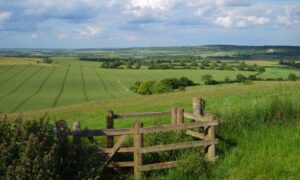
The ploughing up of grass and of land hitherto regarded as waste is changing the face of the Chilterns no less than that of the Berkshire and the Wiltshire Downs. The other day we visited a long Chiltern slope among whose stones, thistles, and ragwort stone-curlews used to nest, and found that it is now green with young corn. A few miles away, too, it was a wheatfield and not the rough ridge studded with mullein, yellow-wort, and pyramidal orchids we expected that we saw as we emerged from a beech wood locally famous for its helleborine orchids.
On the downs the decrease in sheep-rearing is having almost as striking an effect as the increase of cultivation. The turf, which used to be so springy that it gave wings to one’s feet, seems to be losing its resilience now that there are fewer sheep to crop it close, and the eyebright and the milkwort that used to delight one as one walked over it are now too often half-hidden by the growth of coarse grasses. Of the effect of these developments on the habits and distribution of birds it is as yet too early to speak, but already stone-curlews are adapting themselves to the new conditions by nesting in ploughed fields.
